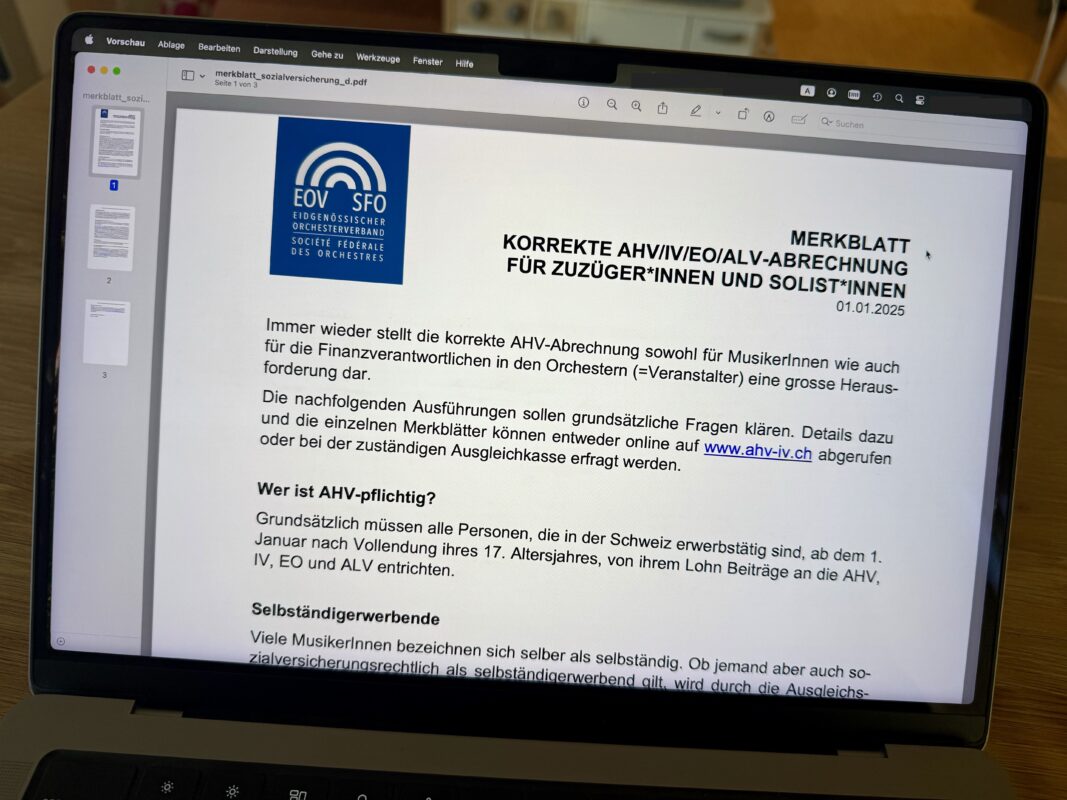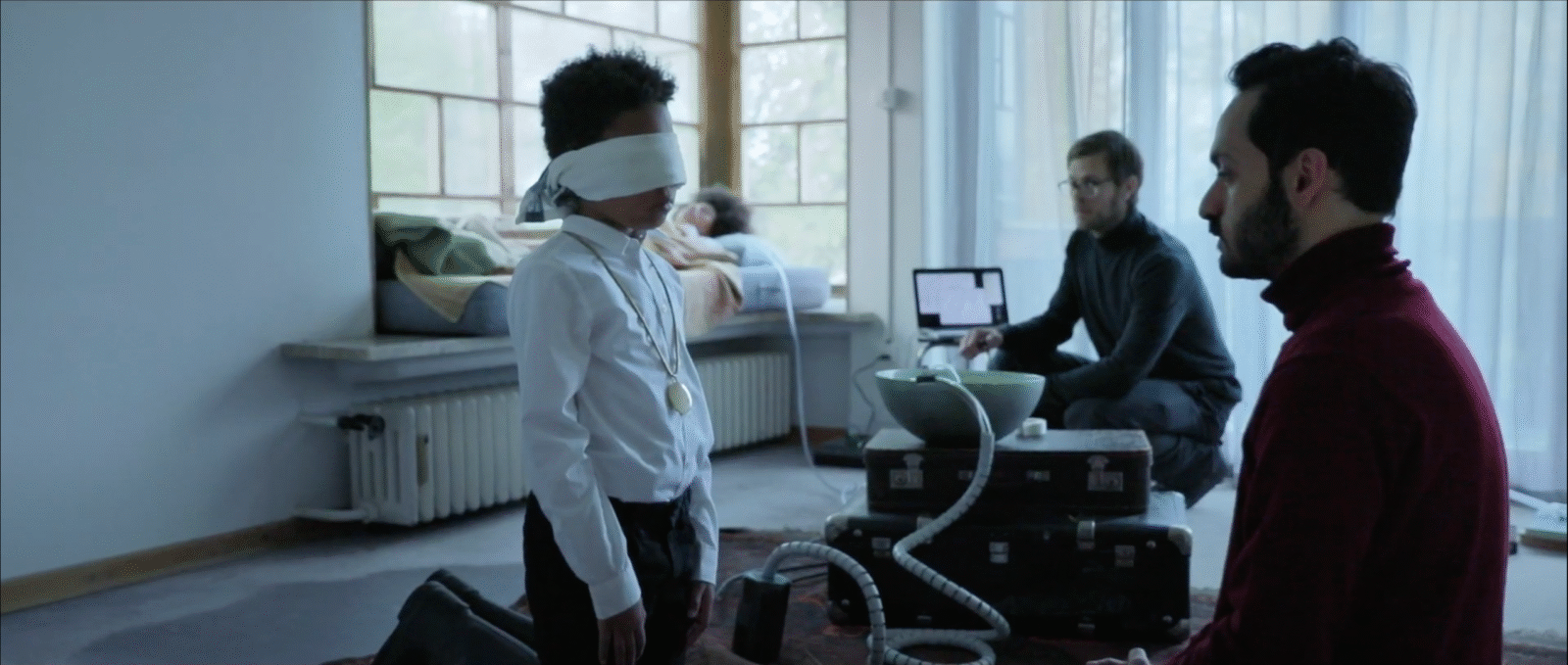The work and achievements of Benno Ammann in Aesch
The versatile composer was also active as a choirmaster in the Basel region. From 1951 to 1959, he conducted the Cäcilienchor Aesch (BL) and created some important works there - despite ups and downs.
Few Swiss composers of the 20th century have left behind an oeuvre with such a broad stylistic spectrum as Benno Ammann. Born in Gersau, he created over 500 works, initially tonal in the style of the Groupe des Six and less progressive in the classical-romantic tradition for amateur music, later turning more and more to the avant-garde cultivated in Darmstadt, and finally working almost exclusively with experimental and electronic music. The latter creative period has been the subject of lively discussion in New Music circles for some time and the Basel Madrigalists brought Benno Ammann's name back into the limelight in 2021 - thanks to their first recording of his most important vocal composition, the Missa Defensor Pacis, which was premiered in St. Peter's Basilica in 1947 on the occasion of the canonization of Brother Klaus.
As the saying goes, where there's light, there's shadow - in a traditionally highlight-heavy musician's biography, it's easy to forget that in contrast to the significant moments in the limelight, there is an everyday existence in the shadows - which is not meant to be as negative as it may sound, because in the shadowy freshness, one works soberly for a living. Benno Ammann not only worked as a celebrated composer and orchestral conductor between Darmstadt and Rome, but also as the director of several amateur choirs in the Basel region. His work in the Roman Catholic parish of St. Josef in Aesch (BL) from 1951 to 1959 is exemplary of this - particularly because during this time Ammann experienced not only compositional highlights but also interpersonal conflicts of the kind that occur wherever people work together and sometimes, unfortunately, against each other.
The circumstances in Aesch that led to Ammann's appointment there in 1951 were already of an all-too-human nature: on White Sunday, an assistant organist missed the start of a hymn during the service, which sparked a dispute between the main organist Hans Kirschner and Pastor Isidor Ottiger that continued to plague parish life until the autumn. In solidarity with the organist, village teacher Fritz Renz also resigned as choirmaster, so that Father Ottiger was able to persuade his school friend Benno from Einsiedeln to succeed him. On October 19, 1951, Ammann conducted the first rehearsal of the Cäcilienchor in the church in Aesch and enjoyed remarkable freedom right from the start despite the six-month rehearsal period. In January 1952, for example, he was granted a longer deputation from May to September to work on compositions. This included attending the Darmstadt summer courses, where he met Olivier Messiaen, among others, but presumably also composing a new festive mass Missa Christus Dominus for the Aesch parish, which was premiered at Easter 1953. This makes us sit up and take notice, especially as there is no evidence that the parish paid the fee for a composition commission. Rather, it seems plausible that Father Ottiger, as President of the Swiss St. Luke's Society for Art and Church, was behind it: at the same time, Ammann was working on the setting of three poems by the Central Swiss poet Walter Hauser (1902-1963) for baritone solo and organ, which were first heard in the orchestral version at the St. Luke's Conference in Zurich in 1954. It is therefore conceivable that Ottiger and Ammann put together a package, as excerpts from the Missa Christus Dominus were presented again in a church music evening celebration in March 1954 together with the premiere of the organ version of the aforementioned Three Spiritual Songs.
Pastor Ottiger never tired of praising the new creations of his intimate. He wrote in the Basler Volksblatt that it was "probably the first time that twelve-tone music was heard in a church concert in our country". As president of the St. Luke's Society, he must have had a good overview of contemporary sacred music; whether it was actually the first performance of sacred twelve-tone music in Switzerland requires further research. Formally, the three pieces with a separate instrumental prelude are conservative and loosely reminiscent of a suite. The harmony is anchored more in the free tonality of the early 20th century than in a dodecaphonic lack of rules. Ammann orchestrated each of the original organ versions differently. No. 1 (Der Weihrauch), with its constantly fanning out recitative tones, is set for string orchestra, the recitative-like No. 2 (Der Kelch) requires additional woodwinds and two horns, and No. 3 (Aufstieg) again requires additional timpani and two trumpets. The baritone, as the melodically concise protagonist, is almost continuously in responsorial dialogue with the harmonically gentle instrumental accompaniment, which seemed to meet the demands of church music and aesthetics at the time and did not overtax the audience in Aesch, who were used to pleasing music. There is a version of No. 1 with a soprano solo, which Ammann created specifically for the premiere in Aesch and which was not included in the final complete version with a baritone solo.
Ammann also premiered two shorter works for choir a cappella at this evening celebration. The first was a simple Ave Maria, composed in 1949 and published two years later by Éditions Schola Cantorum in Paris, and the second was the Litany Anima Christi for choir and baritone solo. Ammann wrote this in 1952 in an early German version and it was praised by Messiaen in Darmstadt as an "œuvre sincère et émouvante": "J'en ai hautement apprécié l'esprit modal, la variété rythmique et le caractère profondément réligieux." The fact that Ammann chose the peripheral town of Aesch, far away from the major church music centers, for the premiere of these highly acclaimed choral works can certainly be seen as a sign of recognition for the Cäcilienchor and as an expression of solidarity with Pastor Ottiger, as the later published version in Latin was premiered under diametrically opposed circumstances: in 1957 as part of the world-renowned Congrès international de musique sacrée III in Paris.
Ammann's main work in Aesch is undoubtedly the Missa Christus Dominus. It is dedicated to Pastor Ottiger and the Cäcilienchor Aesch and sets the Ordinary of the Mass in the usual six movements Kyrie, Gloria, Credo, Sanctus, Benedictus and Agnus Dei. Formally, the work is kept simple; Ammann chose a largely homophonic choral setting with occasional solos from the choral ranks without independent solo parts as well as a demanding, colorfully registered organ accompaniment, which has to play virtuoso passages, especially in the Gloria and Credo. Sanctus and Benedictus are characterized by monophonic melodies with a transparent accompaniment that is reduced to the bare essentials. The Kyrie and Agnus Dei form the framework with a striking third motif ostinato, which Ammann borrowed from the Proprium In festo S. Pauli a Cruce. In a review of the work (published in the Basler Volksblatt on April 20, 1953), music critic Joachim Keller described the harmonies as "free-floating, largely polytonal and even atonal in places", whereby "these different modes of expression blend and dissolve in almost imperceptible transitions, never offending the ear". Like so many new creations, the Missa Christus Dominus was no exception. The quiet movements Sanctus and Benedictus were once again part of the aforementioned evening celebration in March 1954, after which the work disappeared unpublished into the archives. The author of this text, the current director of the Cäcilienchor Aesch, has undertaken a revival of the work, which was given an extremely prominent setting in May 2024 when the choir was invited to the annual swearing-in ceremony of the Swiss Guard in St. Peter's Basilica in Rome - the so-called Sacco di Roma. The mass is aimed at good amateur choirs and professional vocal ensembles. Based on the organ setting, an optional additional accompaniment for string quintet has been added and several choral sections have been marked for optional solo performance. This gives interested choirs the opportunity to perform the Missa Christus Dominus both in its original form and with additional timbres that support the choir with additional string quintet and at the same time relieve the strain thanks to the solo parts.
As much as the first years were characterized by creativity and success, Ammann's reputation in Aesch began to crack. In the spring of 1954, the preparations for the aforementioned evening celebration suffered from many absences by choir members and there were tensions with the young organist Othmar Lenherr, who was still in training, which were resolved thanks to the mediation of Father Ottiger. In collaboration with Father Bertwin Frey (1916-1999) from Central Switzerland, the Prayer Singing Mass in honor of Pius X, also known simply as the German Singing Mass, was composed. The form and content of the seven-movement work for monophonic choir and organ accompaniment are strongly reminiscent of the German High Mass by Michael Haydn or the German Mass by Franz Schubert. The melody is entirely geared towards congregational singing, as is the discreet organ accompaniment, which remains harmonically simple and yet reflects Ammann's style. It was premiered by the Cäcilienchor in Aesch on March 6, 1955. The work will soon be published in a polyphonic arrangement, so that a version for smaller amateur choirs will be available in addition to the original monophonic version.
Conciliatory tones after a long dispute
From November 1956 to June 1958, Ammann also took over as interim director of the church choir in Muttenz. In Aesch, resentment spread due to Ammann's often too short-term program planning. In the summer of 1957, a vice conductor was requested as a regular deputy and in January 1958, the demand for a music commission followed. Once again, there were months of disputes, which were fueled by the dismissal of organist Othmar Lenherr and culminated in an extraordinary general meeting of the Cäcilienchor, which was deliberately not recorded in the minutes. In a three-hour discussion between the church council and the choir board, the reasons for the strong opposition were given: "The choir [was] insufficiently prepared, [...] it was impossible to negotiate with the conductor, he always acted on his own authority. During the singing lessons, he always tried to stop the rehearsals early in order to get home on time." Ammann responded with a request for a dispensation "due to severe professional overload" in order to "devote more time to his own work and the problems of new music". In the fall of 1958, Pastor Ottiger arranged for Josef Hunkeler, a teacher working in Aesch, to become the new organist. Ammann handed in his resignation in June 1959 and recommended Hunkeler as his successor, who subsequently remained director of the Cäcilienchor Aesch for 30 years. In the annual report for 1959, Kuno Stöckli, newly elected choir president and most recently Ammann's deputy conductor, struck a conciliatory note: "His artistic nature made it difficult for him to work successfully with us. We are therefore all the more pleased that his artistic nature has recently led him to various international successes in the field of composition. We would like to thank him for his work with us and wish him many more great successes as a composer."
Who knows how Benno Ammann would have continued to compose in Aesch if the collaboration had not been hampered by mutual inability. This is indicated by the sketch of a polyphonic movement on the Gregorian Tantum ergo, dated June 29, 1953, and another Ave Maria for mixed choir, which Ammann completed on Christmas Day 1953 and presumably had in mind for Aesch, but only added a subsequent dedication for Abbot Benno Gut of Einsiedeln Abbey in 1957. In addition, fragments for another mass setting have been preserved, the Missa sopra AESCH, which Ammann also sketched in 1953 with motifs on the tone sequence A-E-Es-C-H. He does not appear to have pursued any of these works and sketches any further when the first problems arose in spring 1954. Nevertheless, they also document the lively compositional activity that Ammann pursued for church music in Aesch and which - apart from simple arrangements of folk songs - he did not carry out with any of the other choirs that he had directed. It was certainly his long-standing friendship with Pastor Ottiger, which had probably kept him in Aesch longer than was expedient, but was lost after his departure: Ammann left dinner invitations from Ottiger to his home in Aesch, always introduced with "My dear", unanswered.
New edition by Pizzicato Verlag Helvetia
It is thanks to the interest of Pizzicato Verlag Helvetia that, in addition to the electronic works by Benno Ammann, all the works from his Aesch period discussed here are also being published in a new edition: The Missa Christus Dominus with optional string accompaniment; the Deutsche Singmesse with optional polyphonic choral setting; the Drei geistliche Gesänge in all surviving versions for soprano, baritone, organ and orchestra; the Litany Anima Christi in all surviving versions for female or mixed choir as well as in German and Latin; two settings of the Ave Maria and a polyphonic setting of the Gregorian Tantum ergo; and the fragments of the Missa sopra AESCH with optional completion into a performable version. In this way, a representative, stylistically broad selection of Benno Ammann's artistically significant and practice-oriented oeuvre for various formations at home and abroad can be made accessible on the basis of a self-contained creative period: Amateur, church and professional choirs, soloists as well as instrumental ensembles from organ to string quintet to orchestra. The works will be available from the publisher from fall 2024.








